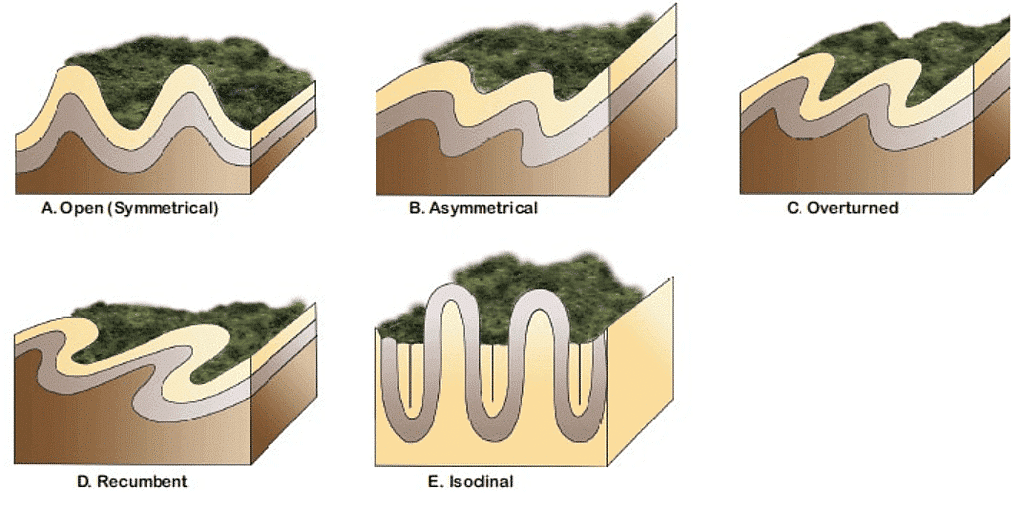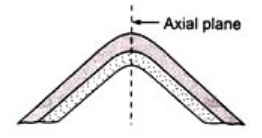Best Study Material for UPSC Exam
UPSC Exam > UPSC Notes > Geology Optional Notes for UPSC > Classification of Folds
Classification of Folds | Geology Optional Notes for UPSC PDF Download
| Table of contents |

|
| What is a fold? |

|
| Geometry of a fold |

|
| Types of folds |

|
| Classification of folds |

|
| Characteristics of fold mountains |

|
What is a fold?
- A fold is an undulating structure (wave-like) that forms when rocks or a part of the earth’s crust is folded (deformed by bending) under compressional stress. The folds are made up of multiple strata (rock layers).
- The folds that are upwardly convex are called as anticlines. The core (centre) of an anticline fold consists of the older strata, and the strata are progressively younger outwards.
- In contrast, the folds that are downwardly convex are called synclines. The core of a syncline fold consists of the younger strata, and the strata are progressively older outwards.
Geometry of a fold
- An upward fold is called an anticline, while a downward fold is called a syncline.
- In many areas, it’s common to find a series of anticlines and synclines, although some sequences of rocks are folded into a single anticline or syncline.
- A plane drawn through the crest of a fold in a series of beds is called the axial plane of the fold.
- The sloping beds on either side of an axial plane are limbs.
- An anticline or syncline is described as symmetrical the angles between each limb and the axial plane are generally similar, and asymmetrical if they are not.
- If the axial plane is sufficiently tilted that the beds on one side have been tilted past vertical, the fold is known as an overturned anticline or syncline.
- A very tight fold, in which the limbs are parallel or nearly parallel to one another is called an isoclinal fold
- Isoclinal folds that have been overturned to the extent that their limbs are nearly horizontal are called recumbent folds.
- Folds can be of any size, and it’s very common to have smaller folds within larger folds.
- Large folds can have wavelengths of tens of kilometres, and tiny ones might be visible only under a microscope.
- Anticlines are not necessarily, or even typically, expressed as ridges in the terrain, nor synclines as valleys.
- Folded rocks get eroded just like all other rocks and the topography that results is typically controlled mostly by the resistance of different layers to erosion.

Types of folds

- An asymmetrical fold is one in which the axial plane is vertical.
- An asymmetrical fold is one in which the axial plane is inclined.
- An overturned fold has a highly inclined axial plane such that the strata on one limb are overturned.
- A recumbent fold has an essentially horizontal axial plane.
- An isoclinal folds limbs that are essentially parallel to each other and thus approximately parallel to the axial plane.
 |
Download the notes
Classification of Folds
|
Download as PDF |
Download as PDF
Classification of folds
Folds are classified into two main types namely anticlines or up-folds and synclines or down-folds.
- Anticline Folds: An anticline consists of beds bent upwards with limbs dipping away from each other.

- Syncline Fold: A syncline consists of beds bent downwards with limbs dipping towards each other.

- Symmetrical Fold and Asymmetrical Fold: A symmetrical fold is a fold whose axial plane is vertical and the limbs dip equally. The axial plane in this case divides the fold into two halves. If the two limbs dip at different angles the fold is an Asymmetrical fold.
- Monocline: This is a fold in which only one limb is bent. This is a case when a rock bed bends abruptly and resumes the original attitude at the lower level.

- Plunging Fold or Pitching Fold: This is a fold whose axis is at some angle with the horizontal. The inclination of the fold axis with the horizontal is called the plunge of the fold.

- Isocline or Carinate Fold: This is a fold whose limbs dip at the same angle in the same direction. The two limbs in this case are parallel. The axial plane may be vertical, inclined or horizontal.

- Overturned Fold: This is a fold whose limbs dip unequally in the same direction.

- Recumbent Fold: This is a fold whose limbs are bent back on themselves almost horizontally.

- Zigzag Fold or Chevron Fold: This is a fold having a sharp angular crest or trough.

- Supratenuous Fold: This is a fold whose beds are thinner at the crest and thicker at the trough. Such folds are formed due to contemporaneous sedimentation, compaction over irregular surfaces uplift folding, sinking etc. These folds are produced by tangential pressures which lift up the beds slowly and vertically at the crests. The thick troughs are formed due to sinking and large accumulation of sediments.

- Dome Fold or Quaquaversal Fold or Pericline: A Dome fold consists of a set of rock beds lifted centrally giving the feature of a dome. The area of the rock bed lifted may be circular or oval-shaped. In a vertical section through the summit, the fold exhibits an anticlinal feature. For this reason, this fold is also called a compound anticline. After the domes are eroded, the younger rocks appear surrounding the older rocks.

- Basin Fold or Centrocline: A-Basin fold consists of a set of rock beds that are sunk down centrally giving the feature of a basin. The area of the rock bed sunk may be circular or oval-shaped. In a vertical section taken centrally, the fold exhibits a synclinal feature. For this reason, this fold is also called a compound syncline.

- Fold mountains: Fold mountains are created when two or more of Earth’s tectonic plates are pushed together. At these colliding, compressing boundaries, rocks and debris are warped and folded into rocky outcrops, hills, mountains, and entire mountain ranges. Fold mountains are often associated with continental crust. They are created at convergent plate boundaries, sometimes called continental collision zones or compression zones. Convergent plate boundaries are sites of collisions, where tectonic plates crash into each other. Compression describes a set of stresses directed at one point in a rock or rock formation. At a compression zone, tectonic activity forces crustal compression at the leading edge of the crust formation. For this reason, most fold mountains are found on the edge or former edge of continental plate boundaries. Rocks on the edge of continental crust are often weaker and less stable than rocks found in the continental interior. This can make them more susceptible to folding and warping. Most fold mountains are composed primarily of sedimentary rock and metamorphic rock formed under high pressure and relatively low temperatures. Many fold mountains are also formed where an underlying layer of ductile minerals, such as salt, is present.
Some examples of Fold mountains are The Himalayas, the Rockies, The Alps, the Aravallis, etc.
Characteristics of fold mountains
- Fold mountains are formed when sedimentary rock strata in geosynclines are subjected to compressive forces.
- They are the loftiest mountains, and they are generally concentrated along continental margins.
- Fold mountains belong to the group of youngest mountains of the earth.
- The presence of fossils suggests that the sedimentary rocks of these folded mountains were formed after the accumulation and consolidation of silts and sediments in a marine environment.
- Fold mountains extend for great lengths whereas their width is considerably small.
- Generally, fold mountains have a concave slope on one side and a convex slope on the other.
- Fold mountains are mostly found along continental margins facing oceans (C-O Convergence).
- Fold mountains are characterized by granite intrusions (formed when magma crystallises and solidifies underground to form intrusions) on a massive scale.
- Recurrent seismicity is a common feature in folded mountain belts.
- High heat flow often finds expression in volcanic activity (the Himalayas are an exception, because of C-C convergence).
- These mountains are by far the most widespread and also the most important.
- They also contain rich mineral resources such as tin, copper, gold etc.
The document Classification of Folds | Geology Optional Notes for UPSC is a part of the UPSC Course Geology Optional Notes for UPSC.
All you need of UPSC at this link: UPSC
FAQs on Classification of Folds - Geology Optional Notes for UPSC
| 1. What is a fold in geology? |  |
| 2. What are the types of folds that can occur in rock layers? |  |
Ans. The types of folds that can occur in rock layers include anticlines, synclines, monoclines, and complex folds with multiple bends.
| 3. How are folds classified based on their geometry? |  |
Ans. Folds are classified based on their geometry as open folds (gentle bends) and tight folds (tight bends), depending on the angle of the fold axis and the degree of curvature.
| 4. What are the characteristics of fold mountains formed by tectonic forces? |  |
Ans. Fold mountains are characterized by long ridges and valleys created by the folding of rock layers under compressional forces, such as the Himalayas and the Appalachian Mountains.
| 5. How are folds classified in the context of UPSC exams? |  |
Ans. In the context of UPSC exams, folds are classified based on their impact on geological structures, formation processes, and their significance in understanding the Earth's history and tectonic activities.
Related Searches



















